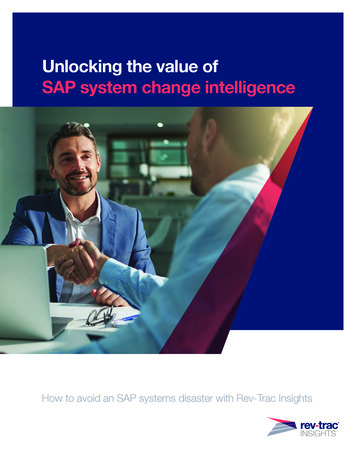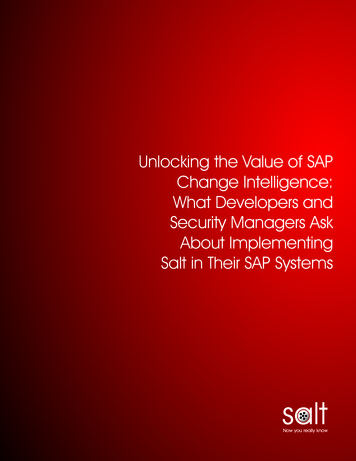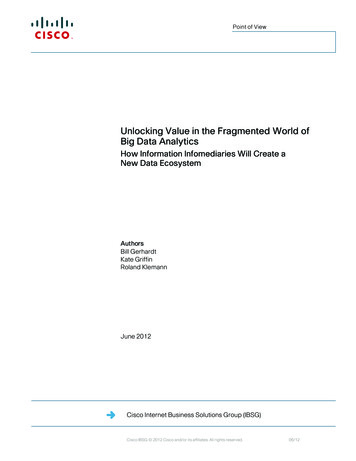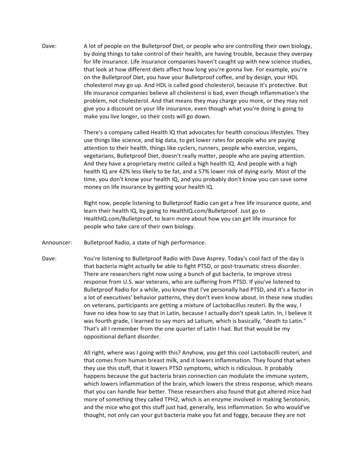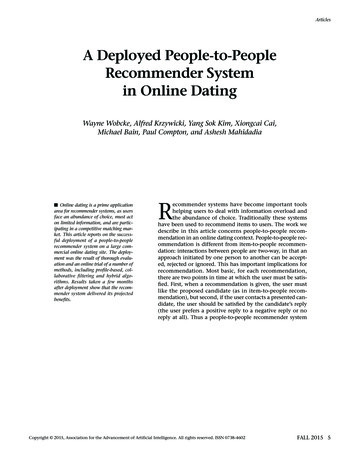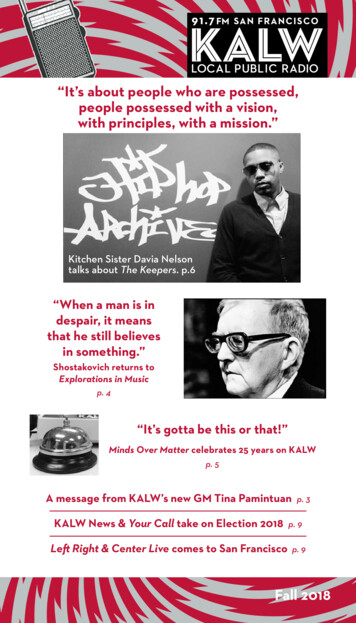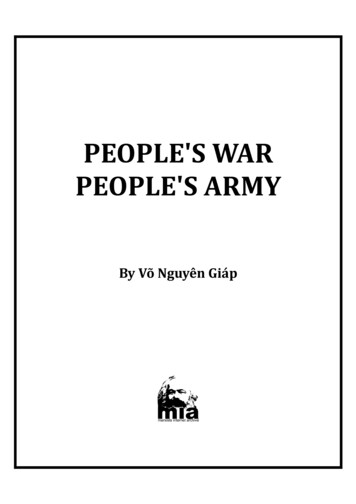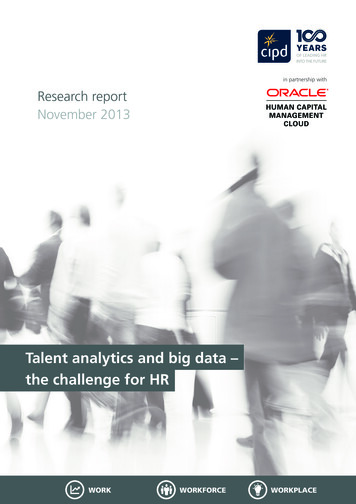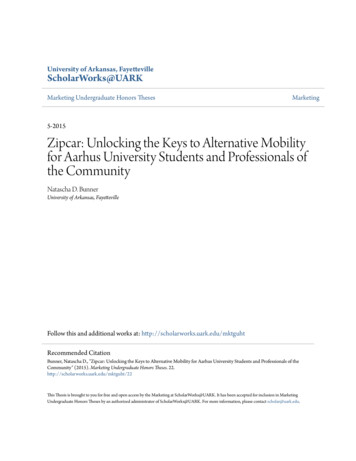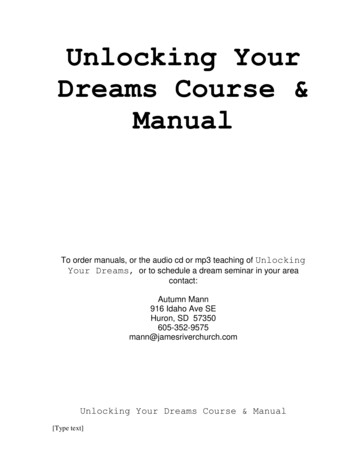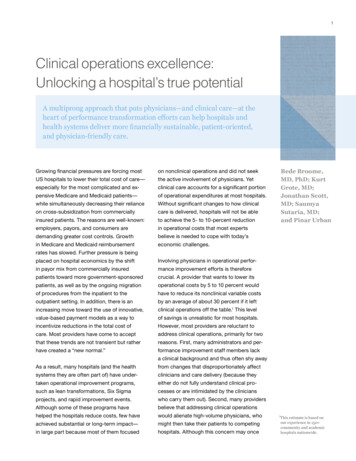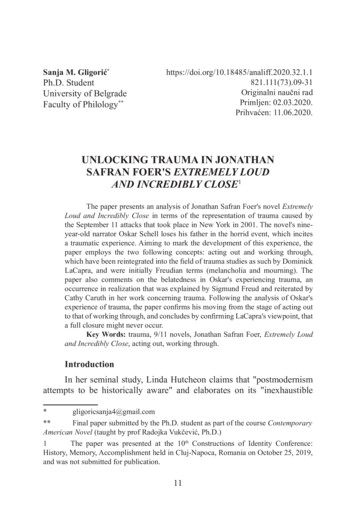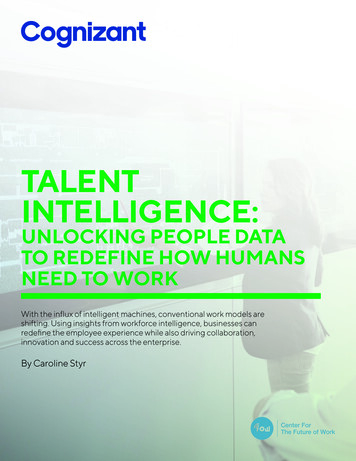
Transcription
TALENTINTELLIGENCE:UNLOCKING PEOPLE DATATO REDEFINE HOW HUMANSNEED TO WORKWith the influx of intelligent machines, conventional work models areshifting. Using insights from workforce intelligence, businesses canredefine the employee experience while also driving collaboration,innovation and success across the enterprise.By Caroline Styr
Employee data will be the keyto finding and retaining toptalent; fostering productivity,performance and well-being;and driving agile, flexibleattitudes toward humanto-human and human-tomachine collaboration thatunlocks innovation.September 2018
Executive SummarySince the dawn of work, humans have been doing the work of machines: executing repetitive tasks forallotted amounts of time. The structures surrounding work – schedules, the work environment, tools –were devised to make humans more machine-like.But now, actual machines, driven by artificial intelligence (AI), are taking their rightful place as theagents of monotonous work, and for humans there’s new – infinitely more valuable – work on the hori1zon: human work. The Fourth Industrial Revolution relies on human capability more than ever, including empathy, complex problem-solving, creativity and, of course, innovative thinking.Because work is changing, the way people work also needs to change. This means investing in a betterunderstanding of employees, and devising new work structures based on this workforce intelligence.While it’s been an under-utilized asset thus far, employee data will be the key to finding and retaining toptalent; fostering productivity, performance and well-being; and driving agile, flexible attitudes towardhuman-to-human and human-to-machine collaboration that unlocks innovation.This white paper explores how businesses can use workforce intelligence to transform how work getsdone and support new models of work, particularly in the following ways: Embrace fluidity: Skills regeneration is the new norm. Yes, workers are changing jobs more thanever. Sure, millennials have no interest in settling down. Rather than fight it, however, businessesshould embrace this fluidity to empower the modern workforce. Skills regeneration is foundationalfor continuous innovation. Real-time skills profiles, developed through employee data, can enableagile workforce planning and make way for authentic, personalized learning programs. Uncover “the natural network” and make way for agile collaboration. Data-driven insights canbreak down restrictive structures that dampen the innovation process by helping businesses understand how work actually happens. With evidence-based insights, businesses can bypass the formallines inscribed in the org chart to bring the right people together at speed.Talent Intelligence: Unlocking People Data to Redefine How Humans Need to Work 3
Enable performance, productivity and well-being. The human workforce has distinct needs, sobusinesses can’t treat humans like machines. Workforce intelligence will reveal unique attitudestoward work and inform work structures that support the individual. This, in turn, will lead to betteremployee engagement, well-being and, ultimately, productivity. Personalize the employee experience to attract – and retain – top talent. Workers are accustomed to digital experiences that are tailored to the individual: personalized recommendations, payment with a fingerprint, automatic updates for the traffic on the commute. Meanwhile, talentmanagement processes are mired in clunky, manual and frustrating practices. Using workforce intelligence, businesses can usher in new levels of employee experience that rival customer experiences. Leverage information about employees, without being creepy. With tales of data misuse hittingthe headlines on a seemingly daily basis, organizations are right to tread carefully. But rather thanusing data privacy fears as a scapegoat for inaction, businesses need to develop policies around theethical and appropriate use of employee data to avoid backlash.Of course, with any use of personal data, privacy issues are of the utmost importance, and this is no dif2ferent with workforce intelligence. A recent study by Insight222 reveals that a staggering381% of people analytics projects are jeopardized by ethics and privacy concerns. For example, whenThe Daily Telegraph introduced sensors in 2016 to monitor space usage in its offices, with the goal ofreducing its real estate footprint and lowering costs, it was forced to remove them a day later due to4widespread unrest among the staff, who “resisted Big Brother-style surveillance in the newsroom.”We’ll cover key aspects of ensuring ethical use of workforce intelligence throughout this report.4 Talent Intelligence: Unlocking People Data to Redefine How Humans Need to Work
THE GREATWORKFORCEREVEALTalent Intelligence: Unlocking People Data to Redefine How Humans Need to Work 5
Just as consumers generate data with every click and swipe, employees also create a plethora of information about themselves, from how they feel about their employer, to hidden talents, to which cowork5ers or workspaces optimize their productivity. This data, both structured and unstructured, can besurfaced through a variety of mechanisms, including systems of record (such as human capital management systems), employee surveys, productivity apps, social media, sensors and more (see Figure 1).Workforce intelligence describes the use of this data to drive a deeper, more meaningful level of humanunderstanding. These insights can be used to inform not only how businesses manage their workers butalso how they drive collaboration, innovation and success across the enterprise.Currently, businesses can achieve the following with insights gleaned from workforce intelligence:A Wide Range of Employee DataThrough their digital actions, employees generate a multitude of insights about themselves, through a variety of mechanisms.InternetSmart workplace HR Finance Environmental sensors(e.g., temperature, light) Space management sensors People sensors (e.g., beacons) Sales & businessperformanceSocialnetwork Email, phone, IM,videoconferencing Collaboration platforms(e.g., Slack)Behavioral/neurological Digital badges(e.g., Humanyze)External Cognitive testing Social media and review sites(e.g., Glassdoor) Emotion detection Demographic and economic data Behavioral monitoring Scientific researchSelf-reportedsentiment Surveys 360 feedbackFigure 16 Talent Intelligence: Unlocking People Data to Redefine How Humans Need to WorkPerformance &productivity Activity analysis (e.g.,Microsoft MyAnalytics,Do.com)
Just as consumers generate data withevery click and swipe, employees alsocreate a plethora of information aboutthemselves, from how they feel abouttheir employer, to hidden talents,to which coworkers or workspacesoptimize their productivity. Gain a real-time understanding of worker sentiment during times of change or turbulence. Duringan ultimately unsuccessful hostile takeover bid in 2017, Unilever conducted sentimentanalysis across internal surveys and social media, as well as on external sources like Glassdoor. As a result,6the company was able to glean employees’ reaction to how it was responding, in real-time. Respond with agility to fast-changing skills needs. At IBM, employees create individual skills profiles, which are updated in real-time. With this information, IBM can provide relevant, personalized7skills training and recommend new job opportunities.In the near future, businesses will advance to new capabilities using workforce intelligence, such as: Protect employee well-being. It’s mid-afternoon, and Gabriel’s levels of concentration havedropped. Behavioral sensors detect this decline in focus, and his calendar is automatically updatedwith a 15-minute block for him to step away from his desk. Build intelligent teams. Steve, Emily and Sanjeev are a high-performing, highly-complementaryteam. Social network analysis quantifies this assumption, and informs the company how to buildfuture successful teams.Talent Intelligence: Unlocking People Data to Redefine How Humans Need to Work 7
THE FUTUREOF WORKRELIES ONEVIDENCE8 Talent Intelligence: Unlocking People Data to Redefine How Humans Need to Work
Workforce intelligence is not just an HR concern; its impact spans the business, addressing the cornerstones of today’s successful digital enterprise: rapid cycles of innovation, agility and humancentered approaches to work. In particular, workforce intelligence can support business efforts to: Enable a skills regeneration mindset. Increase retention of top innovators. Build agile teams for collaboration and co-creation at speed.THE BIG BROTHER BURDEN #1The New T&Cs:From Terms & Conditions,to Transparency & ClarityPeople are increasingly aware of how their data is being used (and abused). From the Facebook andCambridge Analytica scandal,8 to inboxes clogged with hundreds of emails addressing Europe’sGeneral Data Protection Regulation (GDPR),9 data privacy is top of mind, globally.Organizations can’t get away with blinding employees with hyperbole and over-intellectualized termsand conditions. In times when trust is a necessity, organizations should only communicate datacollection efforts in one way: transparently and clearly. Find the best way of communicating – it might not be a blanket email to “companyALL.” Trydeveloping and then utilizing a network of workforce intelligence advocates to share information ina more colloquial way and provide an opportunity for genuine questions and feedback. Keep communication consistent, especially when it comes to voluntary participation. Ensure thatall employees are aware of their right to opt out at any time. Don’t underestimate the importance of give-to-get. Let employees be an integral part of decision making. Embrace the connected culture to instill a greater sense of value among the workforce.Talent Intelligence: Unlocking People Data to Redefine How Humans Need to Work 9
The Skills-Regeneration MindsetInsights gleaned from both employee data and external labor market data can enable skills regeneration across the workforce, which is particularly crucial in today’s world of fast-changing and hard-to-findskills.In our recent report “People – Not Just Machines – Will Power Digital Innovation,” our study revealed10that the main driver for digital skills acquisition across the workforce is to accelerate innovation. Morethan just “one-off” digital skills acquisition, skills regeneration is the ability to upskill and reskill iterativelyto ensure continuous innovation.Many organizations, however, don’t support continuous reskilling, with only 50% of employees saying11their organization has a skills regeneration mindset in one study. Accurate, accessible employee datacan encourage skills regeneration in the following ways: Look into the crystal ball. Organizations are struggling to understand which capabilities theyrequire now and in the future. Indeed, predicting which skills will come in and out of demand hasbecome a big business. LinkedIn earned the reputation of having the most reliable, up-to-date skills12database on the web, helping to raise the company’s value to 26.2 billion in 2016.13A number of start-ups have also emerged in this space; for example People-Analytix uses AI to trawlonline job advertisements to predict the durability of skills. By investing in an engine of big data processing and predictive analytics, and tapping into external data sources (e.g., skills and employmentindicators), businesses can keep up with the fluid skills market. Generate real-time skills profiles. The fitness industry is bursting with applications that monitorhealth goals in real-time, updating with every run, meal and sleep cycle. Organizations can treat skillsfitness in the same way. Real-time skills profiles for each employee should update with every coursetaken, skill deployed or e-learning course completed. With this on-demand insight, workforce planning can become more efficient than ever. For example, HERE Technologies appliesreal-time data to skills, capabilities and interests to match people with opportunities. This, in turn,14drives employee engagement, as people have access to work that most interests them. Increase upskilling with personalized, connected learning programs. Personalized recommendations, authentic learning plans and real-time progress reviews can be made possible with skillsdata surrounding the employee. By investing in a relevant, individualized experience,businesses can boost employees’ confidence and reduce their fear of becoming obsolete, which, inturn, would ensure workers’ commitment to continuously keeping skills current.The fitness industry is bursting with applicationsthat monitor health goals in real-time, updating withevery run, meal and sleep cycle. Organizations cantreat skills fitness in the same way.10 Talent Intelligence: Unlocking People Data to Redefine How Humans Need to Work
Rather than fear career fluidity, organizations canembrace it by steering themselves toward a similarmentality.In addition to skills, careers themselves have become more fluid, not least because it’s never been easierto find another job, with data-driven platforms matching skillsets to opportunities. Job hunting apps likeJobr and Switch – sometimes described as “Tinder for jobs” – are prime examples. Rather than ringthemselvestowarda similar mentality. Salesforce, for example, uses AI to scan annual review documentation and identifypeople who reference skills or interests they don’t necessarily use in their current role to15recommend new internal opportunities.THE BIG BROTHER BURDEN #2Remember Who Owns the DataIn our recent report “Every Move You Make: Privacy in the Age of the Algorithm,” we wrote about theimportance of “portability:” the ability for consumers to download their data and take it with them.16 Webelieve the same is true for employees when it comes to their own data. Workers should be empoweredto download their skills profile and take it to a potential new employer, as it constitutes an evidence-basedaspect of their CV that provides proof of capability.Businesses also benefit, as recruiters are presented with an evidence-based summary of the authenticskillset of an individual, not one written by employees themselves, and endorsed by genuine colleagues,not friends and family.AXA, for example, provides employees with a tool to create a profile of their skills.17 Employees are encouraged to use this tool to find new role opportunities both internally and externally. The tool uses analgorithm to search online job advertisements, recommending new jobs and new skills that the employee should look to acquire.Talent Intelligence: Unlocking People Data to Redefine How Humans Need to Work 11
Finding (and Keeping) Your Hidden InnovatorsWorkforce intelligence can also propel talent management from a gut-feel endeavor to an evidence-based function that is trustworthy, authentic and reliable. This will ensure that organizations notonly find but hold onto top digital talent.Top talent can be identified by using employee data gathered through analytical methods, such as organizational network analysis (ONA). While AI is great at “the science of the job” (data analytics and patternrecognition), people are great at “the art of the job;” for example, visual cues, emotion, empathy, judgmentand social context. ONA helps quantify these qualities by analyzing the relationships and networks employees build. By analyzing data from virtual sources (email, IM, Slack, videoconferencing, etc.) and even physical sensors (ID badges fitted with location or voice sensors, infrared technology to monitor in-personinteractions), business analysts can reveal essential qualities of high-performing employees that, until now,have been difficult to quantify, such as collaboration, influence and respect.This unbiased, evidence-based approach to identifying top talent isn’t limited to internal use. Thedeployment of AI to analyze swathes of people data in the recruitment process is becoming increasinglycommonplace (the number-one use for workforce intelligence is still recruitment). One professionalservices firm used machine-learning tools to analyze data from the 250,000 applications it receiveseach year. The automation yielded a 500% return on investment and the removal of human bias, leading18to a 15% increase in the number of women who passed through screening.Workforce intelligence could also go a long way toward eradicating prejudice in the workplace, not justin recruitment but also across the organization, for example, by lending veracity to promotion cyclesusing skills profiles to validate development plans.Bringing Together Agile Teams for Effective CollaborationONA can also be used to enhance collaboration by revealing in real-time how people work togetheracross the company (see Figure 2, next page). Through a better understanding of this “natural network”(as opposed to the traditional org chart), businesses can begin to break down restrictive structures andprocesses and bring the right people together at speed.For example, a global consumer goods company used ONA to understand which country performed aparticular financial task most efficiently. The business uncovered one location that was 16% more efficient than the average of all company locations, achieving the same results with 71 fewer person hoursand 40 fewer people. Without workforce intelligence, the company would not have found this bright19spot nor been able to replicate it.Through a better understanding of this “naturalnetwork,” businesses can begin to break downrestrictive structures and processes and bring theright people together at speed.12 Talent Intelligence: Unlocking People Data to Redefine How Humans Need to Work
Businesses can also use workforce intelligence to bring the right people together to foster innovation in20specific team settings. It’s well-proven that “creative abrasion”is vital for innovation,21especially for sparking new ideas or approaches to complex problems. Currently, however, teams arefrequently built using human intuition and gut feel. This often manifests in “comfortable clone syndrome” – team leaders surrounding themselves with people who think alike and share the same interests and training – which is a sure way to stifle creativity.By relying on employee data and even predictive algorithms to inform which people should cometogether, businesses can foster more productive, creative teams. For example, by analyzing the connections between employees, GM was able to determine how to gather the people most likely to have22the biggest impact on innovation and product design to work together on projects and teams.We expect more businesses to begin applying workforce intelligence to team-building. It may soon bethe norm, for example, for companies to tap into neuroscience analytics to understand personality traitsand bring opposing, yet complementary, workers together.From Uninformative Hierarchical Structures, to Insightful Natural NetworksThrough organizational network analysis, businesses can get past the traditional org chart and understand howpeople actually work, sometimes referred to as “the natural network.”Traditional Org ChartNatural NetworkSource: Adapted from the depiction of a “wirearchy” in our book Code Halos. How the Digital Lives of People, Things andOrganizations are Changing the Rules of Business, Wiley, 2014, page 146, https://www.cognizant.com/code-halos.Figure 2Talent Intelligence: Unlocking People Data to Redefine How Humans Need to Work 13
THE BIG BROTHER BURDEN #3Who’s Watching?For years, leaders have tackled the question of, “How transparent is too transparent?” One of the most23common debates, for example, is whether to share salary information
The Daily Telegraph introduced sensors in 2016 to monitor space usage in its offices, with the goal of reducing its real estate footprint and lowering costs, it was forced to remove them a day later due to widespread unrest among the staff, who “resisted B
